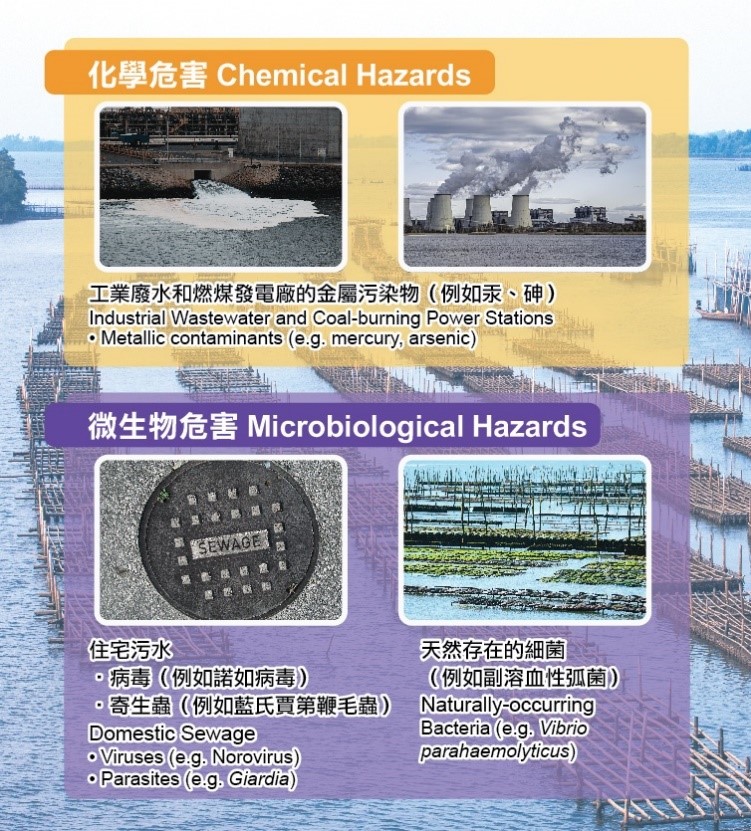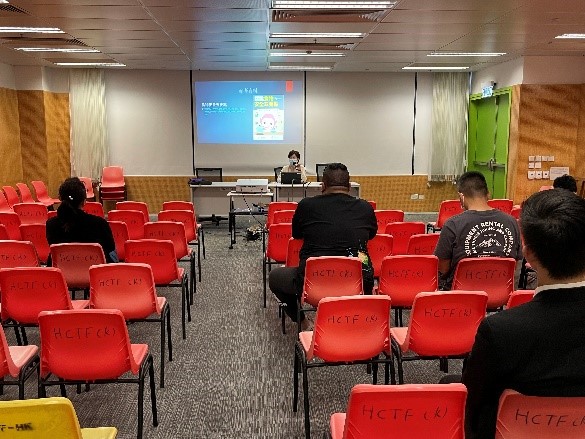
Feature Article
Minimising Health Risks of Oyster Consumption in Snack Food
Oysters are filter feeders and susceptible to contamination from pathogens and chemicals, posing potential food safety risks. Consuming contaminated oysters can lead to food poisoning and health problems. This article highlights the health hazards of oyster consumption and surveillance conducted locally to monitor these hazards, and provides advice on how to reduce food safety risks from oyster consumption.
Hazards of Oyster Consumption
- Chemical Contaminants
As oysters constantly filter seawater, metallic contaminants, such as cadmium, lead and mercury, from the environment will accumulate in oysters, particularly in their internal organs and digestive tracts. Various industrial activities can lead to the discharge of metallic contaminants into the sea, which may in turn contaminate the oyster harvesting areas nearby. Prolonged consumption of oysters containing excessive cadmium and lead can be harmful to kidneys and neurodevelopment. - Pathogens
As oysters are usually cultivated in coastal waters, they can be contaminated with microorganisms and pathogens in seawater, which can result in food poisoning. Such microorganisms and pathogens include bacteria like Vibrio parahaemolyticus and Vibrio vulnificus, parasites like Giardia lamblia and Cryptosporidium parvum, as well as viruses like norovirus and hepatitis A virus. Vibrio bacteria are naturally present in coastal waters, whereas norovirus, hepatitis A virus and some parasites mainly originate from human faecal contamination. - Antimicrobial-resistant (AMR) microorganisms
Eating raw or undercooked oysters will pose a higher risk of AMR microorganism infection. Whether or not these AMR microorganisms have caused illnesses, they may transfer their AMR genes to other bacteria inside human bodies, reducing the efficacy of antibiotics in future.

Hazards of oysters and possible sources of contamination
Food Surveillance of Oyster Samples
Oysters and related products have been included in the sampling scope of the Food Surveillance Programme of the Centre for Food Safety (CFS). The CFS collects samples at the import, wholesale and retail levels for chemical and microbiological testing to ensure food safety. Recent surveillance findings revealed that, besides one imported raw oyster sample detected with an excessive level of Escherichia coli, the test results of the rest were satisfactory. As the season of oyster consumption approaches, the CFS has stepped up its testing on oyster samples with a view to safeguarding public health. In a recent seasonal food surveillance project, the test results for metallic contaminants in all oyster samples were satisfactory.
How to Reduce Food Safety Risks when Consuming Oysters?
Oysters inherently carry food safety risks regardless of the season or waters of harvesting. To date, no technology can guarantee oysters are completely free of hazards. Maintaining a balanced diet and refraining from overindulgence in oysters can reduce the risk of exposure to excessive metallic contaminants.
To minimise the microbiological hazards, it is desirable to observe the Five Keys to Food Safety when handling oysters. Choose oysters that are fresh, with intact shells and without abnormal odour. Check the expiry dates of prepackaged shucked oysters before purchase. Chilled and frozen oysters should be properly stored at or below 4℃ and ‑18℃ respectively, and the duration of exposure of raw oysters to room temperature should be minimised. Wash hands thoroughly and put on protective gloves before handling oysters. Use different cutting boards and utensils to handle raw oysters and cooked/read-to-eat food separately to avoid contamination. Only serve shucked raw oysters in small portions each time. Once shucked, oysters must be refrigerated at 4℃ or below immediately, protected from contamination and consumed within one day. Oysters not intended for raw consumption must be thoroughly cooked to minimise the risk of food poisoning.
When handling oysters, a number of procedures like rinsing and shucking are often performed at room temperature. Such procedures should not last more than one hour. Before serving, oysters should not be left at room temperature for longer than two hours cumulatively.

Handling of oysters exposed to room temperature for different durations
Key Points to Note
- Oysters may cause chemical and microbiological hazards.
- The CFS conducts food surveillance of oysters and related products.
- Observing the Five Keys to Food Safety can reduce the food safety risks of oyster consumption.
Advice to the Trade
- Collect oysters from reliable sources with health certificates issued by relevant authorities of the exporting countries or regions.
- Obtain permission in writing/endorsement from the Food and Environmental Hygiene Department before selling raw oysters.
- Source oysters that are harvested from areas of clean waters.
Mascot ON in Lesson
Bongkrekic Acid: Uncommon but Fatal Toxin in Certain Food
In late March 2024, Taiwan’s health authority reported a food poisoning outbreak at a restaurant in Taipei, resulting in 34 cases of illness and two fatalities. Clinical specimens of 33 individuals were tested positive for the toxin bongkrekic acid. It was reported that a chef’s hands were tested positive for the toxin, suggesting that the food handled by the chef might have been contaminated. Suspected incriminated food included flat rice noodles and Char Kway Teow. This article sheds light on this fatal toxin and how to reduce the risk.
What is Bongkrekic Acid?
Bongkrekic acid is a heat-stable toxin produced by the bacterium Burkholderia gladioli pathovar cocovenenans (B. cocovenenans), which is ubiquitous in soil and plants. The temperature range for bacterial growth is between 30ºC and 37ºC and that for toxin production is between 22ºC and 30ºC. Cases of bongkrekic acid poisoning were originally reported among people who had consumed fermented corn and coconut-based products. Certain fatty acids, particularly those found in coconut and corn, can facilitate the growth of the bacteria and the production of the toxin.
Target organs of the toxin mainly include the liver, brain and kidneys, causing such symptoms as a lack of energy, dizziness, drowsiness, abdominal pain and vomiting. The incubation period for the illness is reported to be between 30 minutes and 20 hours. In severe cases, death can occur within 1 to 20 hours after the onset of symptoms. According to the review of national surveillance conducted in the Mainland, previous outbreaks have resulted in a high mortality rate of up to 60%.
Food Items with Emerging Risk?
In recent years, outbreaks of bongkrekic acid poisoning due to consumption of certain soaked mushrooms and wet rice noodles have been reported in Guangdong and Zhejiang. The mushrooms implicated in these outbreaks were silver ear fungus (snow fungus) and black fungus, with more cases involving the latter. Typically, the mushrooms in these outbreaks were found to have been soaked for more than two days, while it was generally believed that bongkrekic acid would have unlikely been formed if these mushrooms had been soaked for only a short period of time under normal conditions.
Wet starch products or wet rice noodle products (using rice as the main raw material) have been another type of food linked to outbreaks in the past few years. Similarly, the main cause of toxin production was believed to be prolonged storage (longer than 24 hours specifically) at room temperature. In certain instances, the illegal use of a preservative called sodium dehydroacetate was uncovered. This preservative can inhibit the growth of some fungi and spoilage bacteria but not B. cocovenenans, resulting in a potential risk of bacterial growth without sensory changes when the noodles are spoiled.

Flat rice noodles and black fungus
Good Hygiene Practices for Prevention
Bongkrekic acid is produced in certain high-risk food items when they are left at room temperature for an extended period of time, typically more than a day. For prevention, it is important to maintain time and temperature control of these high-risk food items, even before cooking. For silver ear fungus or black fungus, they should be soaked under refrigeration if overnight soaking is necessary. For wet rice noodle products whose shelf life is more than one day, they should be kept at refrigeration temperature during transportation, storage and sale. This becomes particularly important during warmer months when the temperature is favourable for the growth of B. cocovenenans. Additionally, to minimise the risk of contamination with microorganisms, it is crucial to practise good food hygiene at all times.
Key Points to Note
-
Bongkrekic acid, a heat-stable toxin produced by the bacterium B. cocovenenans, was originally reported among people who had consumed fermented corn and coconut-based products. Consumption of these products has been associated with outbreaks that have a high fatality rate.
- Outbreaks due to consumption of black fungus and wet rice noodles have been reported in the past few years, typically caused by these food items being left under ambient condition for more than a day.
- To protect against this uncommon but fatal toxin, apart from observing good food hygiene, it is important to maintain time and temperature control of the high-risk food items, even before cooking, to minimise the growth of B. cocovenenans that may be present due to contamination.
Advice to the Trade
- Ensure that wet rice noodles or similar products are properly covered or packaged when they are delivered to food premises.
- For wet rice noodles or similar products whose shelf life is more than one day, they should be kept under refrigeration during transportation, storage and sale.
- For delivery at room temperature, make sure the delivery has not taken longer than the agreed transportation time. It is also advisable to store in the refrigerator any stock not intended for immediate use.
Spot Check
Hot Tips for Safe Hot Pot
Hot pot is a popular choice for meals, especially when the weather is cold. It is also suitable for social gatherings at home, where sliced meat, seafood, vegetables and noodles are boiled in a pot of water, soup or congee set on the dining table, and consumed after dipping in condiments amid lively conversations. In this article, we will share some tips for a safe and healthy hot pot meal.

Hot pot is a popular choice for dining at home, especially with a group of people
Be Smart and Use “5 Keys to Food Safety” When Preparing Hot Pot
Choose:
Purchase hot pot ingredients from reputable, licensed retailers. Make sure that the ingredients are fresh and in good condition. For prepackaged food, ensure the packages are intact and the products are still within the use-by date.
Clean:
Maintain good personal, food, and environmental hygiene throughout preparation. Before handling food, before eating, after touching raw meat or seafood, and before touching ready-to-eat food, wash hands properly with liquid soap for at least 20 seconds. Utensils and food contact surfaces should be cleansed regularly. When washing vegetables, rinse them thoroughly under running water. When preparing shellfishes and bivalves, scrub and wash the outer shells with water to remove dirt. Soak live bivalves in water for half a day to reduce the amount of sand and microorganisms. Remove the intestines and gonads from scallops to reduce the risk of contaminants. Be careful when washing raw meat and poultry to avoid contamination by pathogens through splashes. Clean and disinfect the sink and its surroundings afterwards.
Separate:
During a hot pot meal, raw and cooked ingredients are often put close to each other for convenience, which will increase the chance of pathogens from the raw ingredients contaminating the cooked food and also the risk of cross-contamination. Use different sets of chopsticks and utensils to handle raw and cooked food separately. Avoid putting too many dishes on the table to minimise food-to-food cross-contamination.
Cook:
Inadequate cooking is a major food safety risk in a hot pot. Raw food may harbour harmful bacteria and viruses which may survive if the food is undercooked. It can subsequently cause food poisoning after consumption. Whenever water or soup is added, food should only be picked up after the soup has come to a full boil. Refrain from overfilling the pot to prevent uneven cooking. Care should be taken to ensure that larger pieces of food are thoroughly cooked to a core temperature of at least 75°C before consumption. Oysters and shellfish should be heated to a more stringent requirement of an internal temperature of 90°C for 90 seconds, or boiled at 100°C until their shells are open and continue for another three to five minutes to ensure the inactivation of common foodborne viruses like hepatitis A and Norovirus. Thorough cooking can destroy common pathogenic bacteria like Salmonella spp., Vibrio parahaemolyticus and Listeria monocytogenes, or viruses like Norovirus and hepatitis A that may be present in hot pot ingredients.
Safe Temperature:
After bringing the hot pot ingredients home, store them properly. Keep frozen products in a freezer at -18°C or below and chilled products in a refrigerator’s chiller compartment at 4°C or below. Do not defrost food at room temperature. Defrost properly, preferably in a chiller overnight, or under cold running water or in a microwave. Cook the defrosted food instantly and do not re-freeze it if the latter two defrosting methods have been used. Some small frozen items like dumplings and fish balls can be boiled directly from a frozen state and defrosting is not necessary.
Other Noteworthy Issues
Avoid consuming raw eggs or using them as a dip, due to the Salmonella risk. Use pasteurised shell eggs instead. Also, condiments like wasabi or strong wine used in marinating raw seafood cannot kill the bacteria or parasites present. Only foods intended for raw consumption can be eaten raw. Choose soup bases with lower fat and sodium content like plain water or a clear broth. Maintain a balanced diet by including more vegetables as part of the hot pot meal and avoiding overindulgence in high-salt (sodium) and/or high-fat food like fish balls, beef balls, imitation crab sticks, sausages, instant noodles, fatty meat, offal and bones, sacha and mala soup bases, etc. Use condiments like soy sauce sparingly. Do not consume foods that are still scalding hot. Bon Appetit!
Safe Kitchen/Trade Talks/Food Safety Guidelines
Safe Kitchen
Introduction to “Safe Kitchen” Scheme
To facilitate the adoption of the 5 Keys to Food Safety and Good Hygiene Practices (GHPs) by trade members, and ensure food safety in their daily operation, the CFS has integrated the existing channels of risk communication and launched a new platform, namely “Safe Kitchen”, to communicate with the trade. The platform provides food safety information of greater practical importance to meet the operational needs of catering outlets.
The “Safe Kitchen” platform disseminates up-to-date food safety information (including food safety guidelines and relevant legislative amendments) to the trade through a host of channels including WhatsApp, emails and dedicated websites. In response to food poisoning outbreaks in restaurants, the platform will also issue food alerts to remind the trade of the points to note in preventing future occurrences so that the risk of food poisoning can be minimised.
New dedicated websites and risk information exchange platforms will be rolled out under the “Safe Kitchen” Scheme. In addition, training materials tailor-made for the trade and workshops for kitchen staff will be provided to enhance food safety and hygiene awareness among them. Members of the trade are welcome to scan the QR code to download the registration form for the “Safe Kitchen” Scheme in order to receive the latest food safety information in a timely manner.

Trade Talks
Trade Talks 2024

The CFS has organised food safety talks and workshops on GHPs for Food 2024 from March through October to publicise proper food handling among food trade practitioners, with a view to promoting GHPs for Food through the trade’s active participation and collaboration with the government, and facilitating the trade’s implementation of a Food Safety Plan in the food manufacturing process, so as to enhance food safety.
The talks will be conducted in Cantonese. Participants will be awarded a certificate of attendance. Details are available under “What’s New” on the CFS’s website.

Food Safety Guidelines
Prevention of Avian Flu: Food Safety Advice
Raw poultry meat and poultry eggs may be contaminated with bacteria or viruses such as salmonellas or avian flu virus. To avoid getting infected by consuming such food, the best way is to cook the food thoroughly to kill the bacteria and viruses in it. Currently, there is no evidence that properly cooked poultry or poultry eggs is a source of infection. Therefore, as long as poultry meat and poultry eggs are thoroughly cooked, the risk of avian flu infection from food consumption can be significantly reduced.
To find out the points to note on the purchase, handling and consumption of poultry meat and poultry eggs, please click the following link or scan the relevant QR code to view or download the set of guidelines as reference.

Salads and Food Safety

Salads are mixtures of minimally processed ready-to-eat vegetables with or without dressings. Food ingredients like meat, eggs, seafood and fruits may also be added. They are usually served cold, and are considered high-risk food due to the presence of raw or undercooked ingredients. Besides, salads can be contaminated by unclean utensils or food handlers with poor personal hygiene. Storing salads at an improper temperature can also promote bacterial growth.
To reduce the food safety risks of salads, the CFS has updated the Salads - Food Safety Guidelines for Food BusinessesNote 1 and provided some practical advice to the trade and the public. The set of guidelines will be distributed to food premises and in food exhibitions. Food ingredients should be purchased from approved and reliable sources. Pasteurised eggs and milk products are recommended for making salad dressings. Food handlers should maintain good personal and environmental hygiene. Prepared salads should be served immediately or kept at a safe temperatureNote 2. Susceptible populationsNote 3 should avoid consuming high-risk food like salads. Note 1: To learn more about common food safety problems related to salads, food safety measures for the preparation of salads, and advice on personal and environmental hygiene for food handlers, please click the following link or scan the QR code to view or download the set of guidelines:
https://www.cfs.gov.hk/english/multimedia/multimedia_pub/files/salads.pdf

Note 2: To learn more about the information on “safe temperature” in Five Keys to Food Safety, please visit the following webpage:
https://www.cfs.gov.hk/english/consumer_zone/safefood_all/five_keys_apply_store.html

Note 3: To find out what “susceptible populations” is, please visit the following webpage:
https://www.cfs.gov.hk/english/consumer_zone/susceptible_population/index.html

News on CFS
- CFS’s Talk on Recommendations on Preventing Food Complaints
Food complaints not only seriously damage a restaurant’s reputation but may also lead to suspension or cancellation of its licence. In view of the rising trend of food complaints in the past few years, the CFS specially held a talk on recommendations on preventing food complaints for the trade on 8 May to shed light on how to reduce food complaints through “Good Hygiene Practices” (GHPs) and “Hazard Analysis and Critical Control Point” when handling food.

- The 85th Meeting of the Trade Consultation Forum
The 85th meeting of the Trade Consultation Forum was held on 21 June. The CFS and the trade exchanged their views on various topics including “Safe handling of rice and noodles to prevent food poisoning, including Bongkrekic acid poisoning”, “Food safety guidelines for food business on preparation of salads”, “Advance release arrangement for Hong Kong-manufactured food products entering the Mainland Market”, “Extension of operational hours for fresh produce imported via Hong Kong-Zhuhai-Macao Bridge”, and “The Guangdong-Hong Kong-Macao Greater Bay Area Food Standards”. For details of the event, please visit:
https://www.cfs.gov.hk/english/committee/Notes_and_Presentation_Materials_TCF85_20240621.html

- CFS’s Webinars on “Safe Food at School” and “Food Safety of Student Lunch Boxes” for 2024/25 School Year
The CFS strives to ensure food safety at school by conducting yearly and territory-wide inspections of licensed food factories supplying lunch boxes for schools and organising trade talks to remind lunch box suppliers to adhere to GHPs when preparing food. With the approach of the 2024/25 school year, the CFS held webinars on “Safe Food at School” and “Food Safety of Student Lunch Boxes” on 5 and 11 July for school staff and student lunch box suppliers respectively. They covered the safety issues of lunch boxes, high-risk foods, the risk of choking and food allergies, etc. Suppliers were also reminded to follow basic food hygiene/safety principles and ensure that staff members observe good personal and environmental hygiene.


Ask Our Mascots
Freezer Burn of Meat

Mascot On:
Meat that has been left in the freezer for a long period of time will probably show signs of freezer burn, but it should not be discarded just because it does not look perfect. The meat is not spoiled and is still good to eat!
When frozen food (e.g. frozen meat) not properly packaged is stored in a freezer, signs of freezer burn, such as a dry and tough appearance, discolouration and formation of “ice crystals”, may occur. However, they will only affect the quality but not the safety of the food!
To protect frozen meat against freezer burn, package it properly by, for example, putting it in a ziplock bag and removing any excess air before freezing to protect the meat’s surface.
To learn more about how to defrost food safely, please visit:
Enhancement Quiz
1. At what temperatures should chilled and frozen oysters be stored respectively?
- 6℃ and -16℃ or below
- 4℃ and -18℃ or below
- 8℃ and -18℃ or below
- 4℃ and -10℃ or below
2. What is “high sodium food”?
- food with over 200mg of sodium per 100g of food
- food with over 400mg of sodium per 100g of food
-
food with over 600mg of sodium per 100g of food
-
food with over 800mg of sodium per 100g of food
3. Which of the following is not one of the “Five Keys to Food Safety”?
-
Choose safe raw materials
-
Separate raw and cooked food
-
Cook thoroughly
-
Critical limits

Diary of Mascot ON
Industrially Produced Trans Fatty Acids in Local Food
The intake of trans fatty acids (TFAs) can increase the risk of coronary heart disease. There are two major dietary sources of TFAs, namely natural TFAs, which are present in ruminant products (e.g. milk and butter), and industrially produced TFAs (IP-TFAs), which can be found in bakery, deep-fried or margarine products. The World Health Organization (WHO) targets limiting IP-TFAs in food as they are the major dietary source of TFAs and can be replaced with alternative ingredients Note 1.
In response to the call of the WHO and in support of the local Action Plan Note 2, the CFS has amended the relevant regulation Note 3 to ban partially hydrogenated oil (PHO), the main source of IP-TFAs, in food. The CFS’s recent risk assessment study Note 4 on IP-TFAs in local food found that the majority of the samples contain no or a low level of IP-TFAs. Only six (4%) samples exceeded the WHO guidance level of 2g IP-TFAs / 100g total fat. As the amendment regulation on banning PHO came into effect on 1 December 2023, the food trade should ensure that their products do not contain PHO.
Note 1: To find out about “Industrially Produced Trans Fats–A Double Jeopardy for Heart Health”, please scan the QR code to view:

Note 3: Information on the Harmful Substances in Food (Amendment) Regulation 2021 is available on scanning the QR code to view:
Note 4: For more details on the risk assessment study results on industrially produced trans fatty acids content in prepackaged and non-prepackaged food, please scan the QR code to view:





